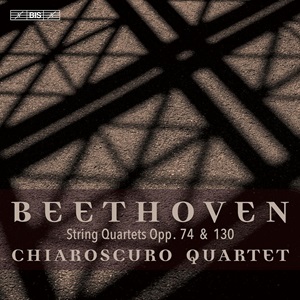
Ludwig van Beethoven (1770-1827)
String Quartet No 10 in E-flat, ‘Harp’, Op 74 (1810)
String Quartet No 13 in B-flat, Op 130 (1825-1826)
Chiaroscuro Quartet
rec. 2022, Wyastone Concert Hall, Monmouth UK
BIS BIS2668 SACD [71]
This SACD includes an interesting pairing of quartets by Beethoven: one from the height of his powers in his middle period, and one of the last quartets, written shortly before his death, when his deafness was nearing totality. The Chiaroscuro Quartet is very much up to the challenge of performing these often difficult works.
The Harp Quartet is frankly excellent in this recording. In the first movement, the tremolos that often dissolve into mush are crystal clear. The “Harp” nickname is derived from the pizzicato handoffs between the violins and between the violin and cello. Here, these handoffs are completely seamless, as they should be. The Allegro of the first movement is taken at a reasonable pace, and not as breakneck as can be heard on some recordings. It’s plenty fast as it is.
The shifting harmonies of the second movement come through beautifully, with delicate phrasing that propels the notes forward. The first violinist, Alina Ibragimova, in particular demonstrates amazing control over the instrument, sometimes nearly vanishing into nothingness. Similar control is on display by all four members in the ferocious Presto of the third movement, which moves so fast I could barely follow the score. Again, it’s very difficult to play so fast, yet keep the sound on the edge of audibility, but the Chiaroscuro Quartet manages it with aplomb, both here and in the 6th variation of the Finale.
The fourth movement is devoted to an Allegretto con Variazioni. I could have done with a bit more staccato in the first variation, in order to heighten the contrast with the second variation. But this is only a niggle. Overall, the variations are allowed their own character without losing sight of the unity. The Quartetto Italiano’s classic recording (Philips 4540622) makes a good comparison point; Chiaroscuro Quartet takes the first movement a bit more relaxed, and the third movement is over half a minute faster here. The tempi are similar to those of the Tokyo String Quartet (RCA LC 00316), but they do not come close to managing the combination of speed and quiet that is heard on this disc. This is a lovely rendition of the Op 74 quartet.
The situation is a little less happy with the Op 130 quartet. This was one of three string quartets that had been commissioned by Russian Prince Nikolai Galitzin back in 1822, and it took Beethoven several years to get around to them. One must say though that the Ninth Symphony was an adequate excuse, and the Prince never pressed Beethoven. He likely had inside information from Beethoven’s former unpaid assistant Franz Oliva, who was then living in St. Petersburg, about how best to approach the composer to get the desired results.
Once again, the first movement Allegro here is quite relaxed. But for some reason, the Chiaroscuro Quartet disregards Beethoven’s numerous marked sforzandi, depriving the movement of much of its impact and excitement. That’s fairly disappointing and I found myself desperately missing the scorching sforzandi, especially on the high F, such as is heard in the Tokyo and Yale String Quartet (Vanguard ATM-CD-1205) recordings of the work. I double-checked the autograph manuscript just to make certain, and those markings are plainly present, so I’m rather at a loss to explain their omission here.
That omission is emphasized by the fact that there are plenty of sforzandos to be heard in the second movement on this recording. Once again, the players demonstrate a wonderful ability to play quietly and fast, as the middle movements are all up to the standard set in the Harp Quartet. The third movement offers nice delicacy, served up in a smooth blend. One would be hard-pressed to find a sweeter fourth movement Tedesca , and the fifth movement Cavatina is unsurprisingly quite lovely as well.
Control turns into repression again in the Finale, where there is a lack of impact even though the tempo is brisker than some, such as the La Salle Quartet (DG 431 141-2) or Tokyo on RCA. There just isn’t enough oomph behind the forte and the fortissimo to make it very convincing as a conclusion to this sprawling work.
Beethoven famously intended the Grosse Fuge to serve as the Finale for this quartet, but was convinced that it was too long and complicated and would serve better standing on its own. The Finale that replaced it was inserted not long before the composer’s death. Although many recordings of Op 130 regularly include the Grosse Fuge, Op 133, allowing one to program the original ending of the quartet, it’s not present here.
Prince Galitzin was a cellist, and Beethoven made sure to provide plenty of interesting material for the lowest voice, all of which is well handled by Claire Thirion. Every one of Beethoven’s indicated repeats are observed, which is certainly welcome.
The recording is up to the usual extremely high standards set by BIS. The sound is free of noise and hiss, and there is extreme clarity throughout, which helps support the fast/quiet combination of the Chiaroscuro Quartet that makes many of the movements on this disc so revealing and rewarding. There is no dynamic compression either, which again makes transparent the skill and control of the musicians.
While this will rank among my top recordings of the Harp Quartet, the ineffective outer movements of the Op 130 quartet are less gratifying, even though the four middle movements are excellent.
Mark S. Zimmer
Mark S. Zimmer is the Project Director of The Unheard Beethoven, a website devoted to the unpublished and unrecorded works of Ludwig van Beethoven, and is the author of the Beethoven 200 Years Ago Today feature found on that site.
Help us financially by purchasing from



















